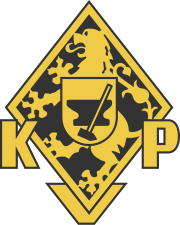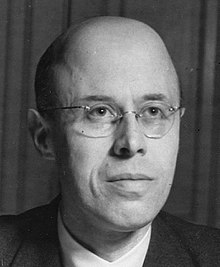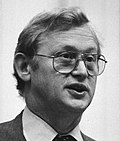Catholic People's Party
Catholic People's Party Katholieke Volkspartij | |
|---|---|
 | |
| Abbreviation | KVP |
| Founder | Carl Romme Josef van Schaik Laurentius Nicolaas Deckers Frans Teulings Max Steenberghe Jan de Quay Louis Beel Teun Struycken |
| Founded | 22 December 1945 |
| Dissolved | 27 September 1980 |
| Preceded by | Roman Catholic State Party |
| Merged into | Christian Democratic Appeal |
| Headquarters | Mauritskade 25 The Hague |
| Youth wing | KVPJO |
| Think tank | Centrum voor Staatkundige Vorming |
| Ideology | |
| Political position | Centretocentre-right |
| Religion | Roman Catholic |
| European affiliation | European Union of Christian Democrats[2] |
| European Parliament group | Christian Democratic Group |
TheCatholic People's Party(Dutch:Katholieke Volkspartij,KVP) was aCatholicChristian democratic[3]political party in the Netherlands.The party was founded in 1945 as a continuation of the interwarRoman Catholic State Party,which was in turn a successor of theGeneral League of Roman Catholic Caucuses.The party was in government throughout its existence. In 1977, a federation of parties including the Catholic People's Party, theAnti-Revolutionary Party(ARP) and theChristian Historical Union(CHU) ran together under theChristian Democratic Appeal(CDA) banner. The three participating parties formally dissolved to form the CDA in 1980.
History[edit]
1945–1965[edit]
The KVP was founded on 22 December 1945. It was a continuation of the pre-warRoman Catholic State Party(RKSP). Unlike the RKSP, the KVP was open to people of all denominations, but mainlyCatholicssupported the party. The party adopted a more progressive course and a more modern image than its predecessor.
In the1946 general election,the party won a third of the vote, and joined the newly foundedsocial democraticLabour Party(PvdA) to form a government coalition. ThisRoman/Redcoalition ( "Roman" for the KVP, "Red" for the PvdA) lasted until 1958. In the first two years, the KVP'sLouis Beelled theCabinet.Beel was not the party's leader, a post which was taken byCarl Romme,who led the KVP from theHouse of Representativesbetween 1946 and 1961. After the1948 general election,the PvdA supplied the prime ministerWillem Drees.The PvdA and the KVP were joined by combinations of theprotestant-ChristianAnti-Revolutionary Party(ARP) andChristian Historical Union(CHU) and theliberalPeople's Party for Freedom and Democracy(VVD) to form oversized cabinets, which often held a comfortable two-thirds majority in the House of Representatives. The cabinets were oriented at rebuilding Dutch society andeconomyafter the ravages ofWorld War IIand grant independence toIndonesia.That last point caused a split within the KVP; in 1948, a small group of Catholics opposed to decolonisation and cooperation with social democrats broke away to form theCatholic National Party(KNP). Under pressure of theCatholic Church,the two parties reunited in 1955.


The KVP was at the height of its power from 1958 to 1965. It was the dominant force in all cabinets, and every prime minister during this time was a party member. In 1958 thefourth Drees cabinetfell and Louis Beel formed an interim cabinet with KVP, ARP and CHU. After the1959 general election,the KVP formed a centre-rightcabinetwith ARP, CHU and VVD, led by KVP memberJan de Quay.It continued to strengthen the welfare state. After the1963 general election,this cabinet was succeeded by a newcabinetof KVP-CHU-ARP-VVD, which was led by the KVP'sVictor Marijnen.This coalition oversaw aneconomic boom.Norbert Schmelzerbecame the party's new leader, again operating within the House of Representatives and not the cabinet. A cabinet crisis over theNetherlands Public Broadcasting,however, caused the cabinet to fall in 1965. The KVP and ARP formed acabinetwith the PvdA, led by the KVP'sJo Cals.This cabinet also fell in the Night of Schmelzer, in which Norbert Schmelzer forced a cabinet crisis over the cabinet's financial policy. This was the first fall of cabinet directly broadcast on television. An interim government of KVP and ARP was formed, led by the ARP'sJelle Zijlstra.
1965–1980[edit]
The period 1965–1980 was period of decline, crisis and dissent for the KVP. The party's vote share began to decline after 1966 as a result ofdepillarisationandsecularisation;there were fewer Catholics, and Catholics no longer necessarily supported a Catholic party.
In the1967 general election,the KVP lost 15% of its votes and eight seats. During the election campaign the KVP, ARP and CHU declared that they wanted to continue cooperating with each other. Cooperation with the PvdA was much less important. This led to unrest among young andleft-wingKVP supporters, includingRuud Lubbers,Jo Cals,Erik JurgensandJacques Aarden,who called themselves Christian Radicals. After the election, this promise was upheld and the KVP formed acabinetwith its old partners, led byPiet de Jong.After much debate, some of the Christian Radicals broke away from the KVP in 1968 to form thePolitical Party of Radicals(PPR). These include three members of parliament, who form their ownparliamentary party,Groep Aarden. Lubbers and Cals stayed with the KVP. The new party became a close partner of the PvdA. In the1971 general election,the KVP lost another seven seats (18% of its vote). The KVP again joined the ARP, CHU and VVD to form a new centre-rightcabinetwith right-wing dissenters of the PvdA, united inDemocratic Socialists '70(DS'70). The ARP'sBarend Biesheuvelled the cabinet. In 1972 the cabinet fell because of internal problems of the junior partner, DS'70.
In thesubsequent election,the KVP again lost eight seats, leaving only 27, 23 less than in 1963. The cabinet lost its majority and the KVP saw no alternative than to cooperate with the PvdA and its allies PPR andDemocrats 66(D'66). Anextra-parliamentarycabinetwas formed by PvdA, PPR and D66 joined by prominent progressives from KVP and ARP. The KVP's ministers include the minister of JusticeDries van Agtand the minister of the Economy Ruud Lubbers. The KVP did not officially support this cabinet, which was led by social democratJoop den Uyl.This cabinet was characterised by infighting and fell just before the1977 general election.
In the 1970s, the KVP realised that if it was to continue, it needed to find new ways of cooperating. Ideas to form a broad Christian democratic party, like the GermanChristian Democratic Union,were brought into practice. In 1974 the three parties formed a federation, calledChristian Democratic Appeal(CDA). In the 1977 election the CDA won more seats than the KVP, ARP and CHU had together. After the election, Dries van Agt became prime minister. In 1980, the three parties officially dissolved themselves into the CDA.
The Catholics still constitute a powerful group within the CDA. Indeed, the CDA's first two prime ministers, van Agt andRuud Lubbers,came from the KVP side of the merger. In the early years, a system of equal representation of Catholics and Protestants was practiced, from which the KVP as the only Catholic group profited. Nowadays many CDA members, likeMaxime VerhagenandMaria van der Hoevenhave a background in the KVP's political Catholicism.
Name[edit]
The name Catholic People's Party (Dutch:Katholieke Volkspartij;KVP), must be seen in contrast with the name of its predecessorRoman Catholic State Party.The party no longer uses the name "Roman Catholic",but simply"Catholic",de-emphasising its religious affiliation. It is no longer a state party, but a people's party, emphasising its progressive, democratic nature. The new name emphasises the KVP's progressive, democratic and non-denominational image.
Ideology[edit]
| Part ofa serieson |
| Christian democracy |
|---|
 |
|
|
The KVP was aChristian democraticparty, which based itself on theBibleand Catholicdogma.
As such, it was a proponent of amixed economy:A strongwelfare stateshould be combined with afree market,with acorporatistorganisation.Trade unionsandemployers' organisationswere to negotiate on wages in aSocial and Economic Counciland should make legislation for some economic sectors on themselves, without government intervention, in so-calledProductschappen.
The state should watch over the morality of the people: divorce should be limited, recreation should be moral (for instance different swimming hours for women and men) and the family should be preserved. Families were to be helped by fiscal policies, such as thekinderbijslag,support by the government, by the newly set up Ministry of Culture, Recreation and Welfare, and the possibility to buy their own home.
Internationally, the KVP was a staunch proponent ofEuropean integrationand cooperation withinNATO.The party sought the middle ground in the issue of decolonisation: Indonesia andSurinameshould be independent countries within a DutchCommonwealth.
Electoral performance[edit]
| Election | Votes | % | Seats | ± | Government |
|---|---|---|---|---|---|
| 1946 | 1,466,582 | 30.8 (1st) | 32 / 100
|
Coalition | |
| 1948 | 1,531,154 | 31.0 (1st) | 32 / 100
|
Coalition | |
| 1952 | 1,529,508 | 28.7 (2nd) | 30 / 100
|
Coalition | |
| 1956 | 1,815,310 | 31.7 (2nd) | 49 / 150
|
Coalition | |
| 1959 | 1,895,914 | 31.6 (1st) | 49 / 150
|
Coalition | |
| 1963 | 1,995,352 | 31.9 (1st) | 50 / 150
|
Coalition | |
| 1967 | 1,822,904 | 26.5 (1st) | 42 / 150
|
Coalition | |
| 1971 | 1,379,672 | 21.8 (2nd) | 35 / 150
|
Coalition | |
| 1972 | 1,305,401 | 17.7 (2nd) | 27 / 150
|
Coalition |
Municipal and provincial government[edit]
| Province | Result (seats) |
|---|---|
| Groningen | 2 |
| Friesland | 3 |
| Drenthe | 2 |
| Overijssel | 14 |
| Gelderland | 21 |
| Utrecht | 12 |
| North Holland | 19 |
| South Holland | 16 |
| Zeeland | 9 |
| North Brabant | 52 |
| Limburg | 39 |
The party was particularly strong in the southern provinces ofLimburgandNorth Brabant,where it often held 90% of the seats in theprovincialandmunicipal legislaturesand supplied allprovincialandmunicipal governments,provincial governorsandmayors.In regions likeTwente,West FrieslandandZeelandic Flandersit held similar positions in municipalities, but cooperated with other parties on the provincial level.
Organisation[edit]
Leaders[edit]
| Leader | Term of office | Age as leader | Lead candidate | ||
|---|---|---|---|---|---|

|
Carl Romme (1896–1980) |
10 January 1946 – 18 February 1961 (15 years, 39 days)[4] |
49–64 | 1946 1948 1952 1956 1959 | |
| Vacant (18 February 1961 – 15 August 1961) | |||||

|
Dr. Wim de Kort (1909–1993) |
15 August 1961 – 7 December 1963 (2 years, 114 days)[4] |
52–54 | 1963 | |

|
Norbert Schmelzer (1921–2008) |
7 December 1963 – 25 February 1971 (7 years, 80 days)[4] |
42–50 | 1967 | |

|
Dr. Gerard Veringa (1924–1999) |
25 February 1971 – 1 October 1971 (218 days)[4] |
46–47 | 1967 | |

|
Frans Andriessen (1929–2019) |
1 October 1971 – 25 May 1977 (5 years, 236 days)[4] |
42–48 | 1972 | |
| Vacant (25 May 1977 – 27 September 1980) | |||||
|
|
|
|
Electorate[edit]
The KVP was supported by Catholics of allclasses.Its strength was in theCatholic south of the Netherlands:North BrabantandLimburg,where it often obtained more than 90% of vote. It was also strong in Catholic regions likeTwente,West FrieslandandZeelandic Flanders.
During the 1960s and 1970s, the KVP lost part of its electorate to progressive parties like thePolitical Party of Radicals,theLabour PartyandDemocrats 66.
Organisation[edit]
Linked organisations[edit]
The KVP had an own youth organisation, the Catholic People's Party Youth Groups (Dutch:Katholieke Volkspartij Jongeren Groupen;KVPJG) and a scientific foundation, the Centre for Political Formation.
International organisations[edit]
In theEuropean Parliamentthe KVP's members sat in theChristian Democratic group.
Pillarised organisations[edit]
The KVP had close links to many other Catholic institutions such as theCatholic Churchand together they formed the Catholicpillar.These organisations included the Catholic Labour Union NKV, the Catholic Employers Organisation KNOV, the Catholic Farmers' Organisation KNBLTB, Catholic Hospitals united in the Yellow-White Cross and Catholic Schools. The Catholic broadcasting associationKatholieke Radio Omroepand the Catholic newspaperDe Volkskrantwere the voices of the KVP.
Relationships to other parties[edit]
As a Christian party, the KVP had strong ties with the conservative ProtestantAnti-Revolutionary PartyandChristian Historical Union.The strong ties resulted in several cabinets in the period from 1946 to 1977 and the formation of theChristian Democratic Appeal,in which the three parties united in 1974.
The KVP had a strong centre-left group within its ranks. These supported closer cooperation with the social democraticLabour Party.This resulted in several cabinets with the PvdA, but also splits within the party, most notably the formation of thePolitical Party of Radicals
As noted by one study, in the early post-war years "the Catholic party was dominated by its left wing, with the result that the PvdA and the KVP had relatively few disagreements on policy issues." Beginning in 1952 however, "the focus of power within the KVP shifted to the right, resulting in frequent conflicts within the cabinet, especially in the area of economic and social policy."[5]According to another study, the Catholic party shifted to the right between 1958 and 1963.[6]Nevertheless, new social welfare benefits were established under successive KVP-led coalition governments.[7]
International comparison[edit]
As the party of a Catholic minority in a dominantly Protestant country, the KVP is comparable to the GermanCentre Party,which existed before World War II, and theChristian Democratic People's Party of Switzerland.Its political position and agenda are similar to other catholic Christian democratic parties in Europe, such as the FlemishChristian Democratic and Flemishparty and the ItalianChristian Democracy.
Logo[edit]
References[edit]
- ^Rietbergen, P. J. A. N. (2000).A Short History of the Netherlands: From Prehistory to the Present Day(4th ed.). Amersfoort: Bekking. pp. 147–148.ISBN90-6109-440-2.OCLC52849131.
- ^Thomas Jansen; Steven Van Hecke (19 May 2011).At Europe's Service: The Origins and Evolution of the European People's Party.Springer Science & Business Media. p. 23.ISBN978-3-642-19414-6.
- ^Peter Starke; Alexandra Kaasch; Franca Van Hooren (7 May 2013).The Welfare State as Crisis Manager: Explaining the Diversity of Policy Responses to Economic Crisis.Palgrave Macmillan. p. 193.ISBN978-1-137-31484-0.
- ^abcde"Politiek leider van een partij".Parlement&Politiek.Retrieved2012-11-03.
- ^Common Destiny A Comparative History of the Dutch, French, and German Social Democratic Parties, 1945-1969 By Dietrich Orlow, 2000, P.91-92
- ^The Economic History of The Netherlands 1914-1995 A Small Open Economy in the 'Long' Twentieth Century By J. L. van Zanden, 2005, P.263
- ^Overheid; sociale uitkeringen 1987 – 2013(From Centraal Bureau voor de Statistiek)
Further reading[edit]
- Electoral Stability and Electoral Change: The Case of Dutch Catholicsby Herman Bakvis in: Canadian Journal of Political Science Vol. 14, No. 3 (Sep., 1981), pp. 519–555
- Bosmans, Jac (2004). Michael Gehler; Wolfram Kaiser (eds.).The Primacy of Domestic Politics: Christian Democracy in the Netherlands.Routledge. pp. 47–58.ISBN0-7146-5662-3.
{{cite book}}:|work=ignored (help) - Changing Procedures and Changing Strategies in Dutch Coalition Buildingby Hans Daalder In: Legislative Studies Quarterly Vol. 11, No. 4 (Nov., 1986), pp. 507–531
- Conservatism in the Netherlandsby Hermann von der Dunk In: Journal of Contemporary History, Vol. 13, No. 4 (Oct., 1978), pp. 741–763
- Catholic political parties
- Defunct political parties in the Netherlands
- Confessional parties in the Netherlands
- Political parties established in 1945
- Political parties disestablished in 1980
- Defunct Christian political parties
- 1945 establishments in the Netherlands
- 1980 disestablishments in the Netherlands
